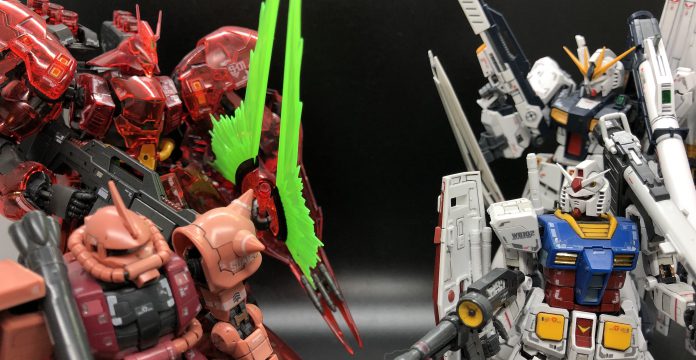In a new type of Bit we’re exploring here on Goonhammer, we’re branching out to cover something that has nothing to do with games or dice: Gundam plastic model kits. If you’re not a big old anime fan, we’re continuing with an exploration of what a Gundam is, and what a GunPla is.
A quick note to start us off: the accepted nomenclature here is “Gunpla”, which is a portmanteau of “GUNdam PLAstic model kit”. I don’t love it either.
Also important: When you see the term “mobile suit”, that’s the generic term for a mech in the Gundam universe, the equivalent to “Titan” or “Battlemech”. A Gundam proper is just a particular mobile suit, usually but not necessarily an experimental design too expensive or dangerous to mass produce – compare to Psi-Titans, or Dies Irae, for example, but the names don’t tend to be as colorful as they are in Warhammer. The setting is just less goth.
The inevitable Bandai/GW comparison
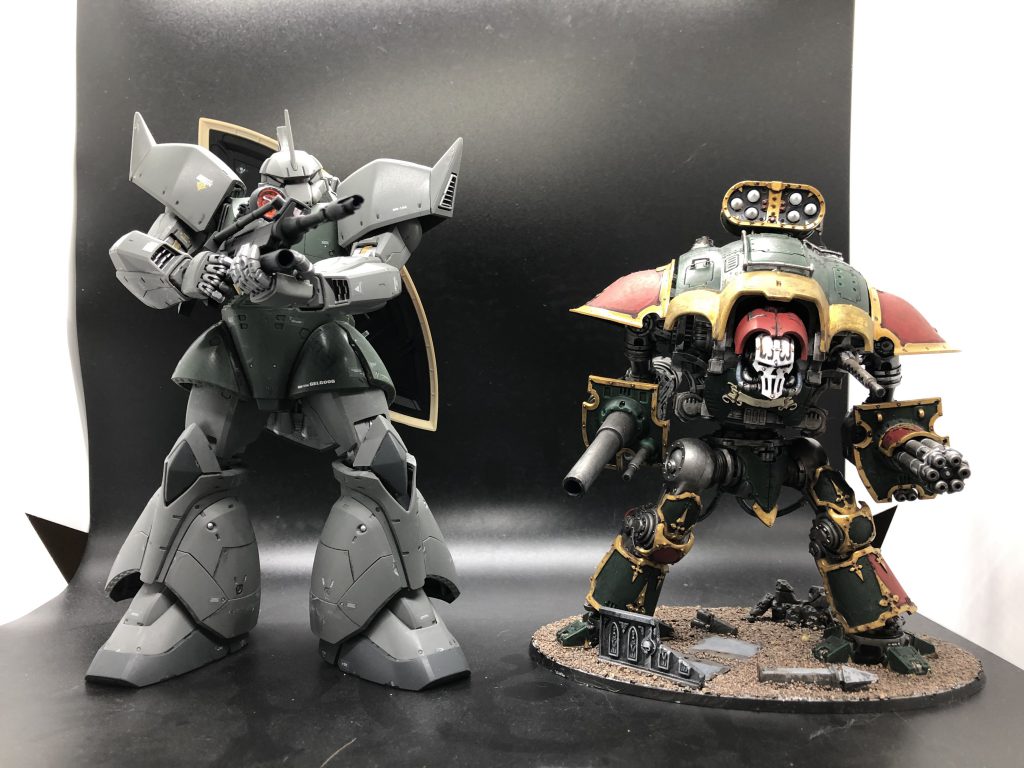
They aren’t the same thing!
This is a hot button issue in both the gunpla and Warhammer communities. You can’t compare GW to Bandai. Yes, it does seem a bit rich that an itty-bitty dreadnought costs twice as much as a giant fully-posable robot, but the robot doesn’t have nearly the same level of detail on it. It also doesn’t require glue or painting, but maybe you see this as a negative on account of you like painting, I don’t know. You should. Also, Bandai is a giant company even compared to Games Workshop, and economies of scale work in their favor too, but that’s not the point.
So which company sucks more at plastic? Stop it. Please stop trying to make this happen. They’re playing completely different games and could easily do what the other does if they felt like it, which they don’t. We actually did get a crossover episode when Bandai produced a line of big-ass Space Marines, and they were fine.
Bandai does some fun things with multi-color runners, or casting movable joints that just need to be cut off the sprue with zero assembly. Games Workshop puts out incredible sculpts with more detail than any plastic model maker on the market, full stop. Not the same!
You could compare a Knight to a Master Grade (we’ll talk about Grades in a bit, but bear with me), and I will, but in the interest of flexing I also happen to have both a Perfect Grade Gundam and a Forgeworld Titan, which are roughly the same size.
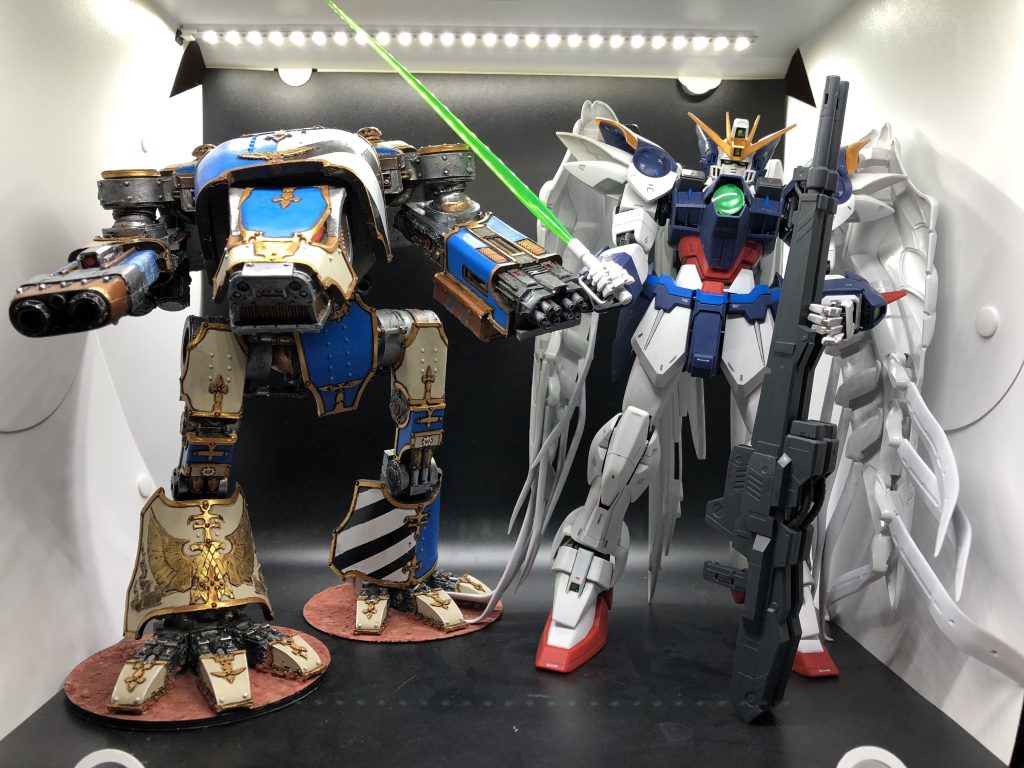
The Titan cost four times as much and was a complete nightmare to build, but the result is covered in rich detailing, and it looks phenomenal. The Gundam has parts that fall off and it tips over if you look at it the wrong way, but you can pose the hands to throw up the devil horns.

They can both be cool, in their own ways, is the point.
How do I do this if I don’t read Japanese?
Fret not: the instructions are fully illustrated and require only Ikea-level literacy. Newer kits will have full English translations, but the runners all use latin characters and the parts themselves use arabic numerals (eg, smash A34 into A35, apply decal 14). Only on the decal sheets, and only on older releases, you might have to match up some Kanji to see what goes where, but Bandai have come a long way in localizing since then.
Even in the most dire case, there’s usually only one way two parts can go together, and if you mash them together wrong (how??) it’s not a huge effort to disassemble and reassemble. Take your time, and after the first couple of builds, it comes together almost on its own. If something breaks while you’re doing this, it’s all plastic, and can be glued. In the absolute worst case you ruin a $20 model, and I’ve seen enough bad Ork conversions to know how little of a barrier that represents.
As for tools, if you collect miniatures you have what you need already: a pair of cutters, and a sharp hobby knife. There are other things you might want, but that’s seriously all you need.
What is a “grade”?
A given mobile suit will be available in one or many different model kits, of varying quality. The most obvious differences are size – from just a few inches to over a foot tall – and the amount of detail and corresponding build complexity. The cheaper models tend to be more “anime accurate”, because the anime designs are bland as hell due to low budgets, but the higher detail on the more complex models comes closer to the concept art. The main differences involve how many parts you’re dealing with. Specifically, how tiny they are, whether they’re the right color, and how much detail they have molded into them. This is a “grade” – a set of expectations you can carry into a kit, and a rubric for comparing them against each other.
Popular designs will be available in a few variations at different grades, so you have options for how good of a robot you want, based on how much time and effort you want to put into it.
HG: High Grade (1/144)
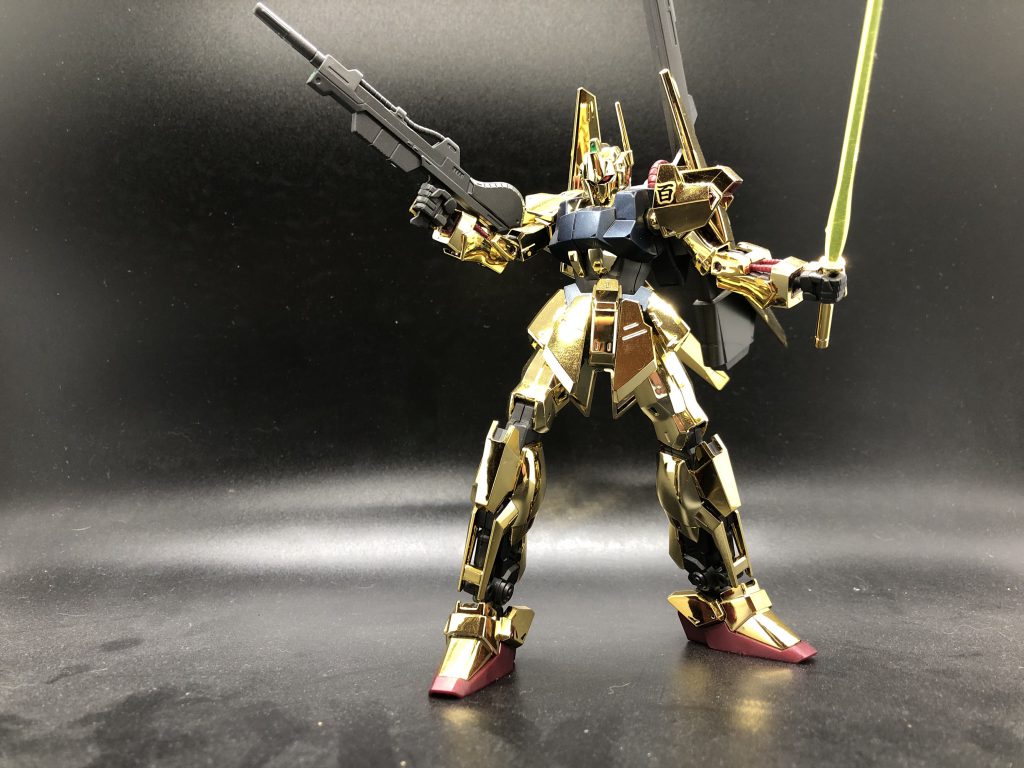
The usual starting point for new robot enthusiasts, High Grades are quick builds that even an inexperienced builder can slap together in an afternoon or two. They generally don’t come with waterslide decals, or even the good kind of stickers (warning labels and little decorative stripes) but often have the bad kind of stickers (color-correcting the parts that Bandai didn’t spend the effort to cast properly).
The trade off for the least fancy robot is price: the typical High Grade will run you fifteen or twenty bucks. These run small – usually but not exclusively less than 6 inches tall – but the range covers literally hundreds of models, so almost anything you want can be found here, and often only here.
High Grades are numbered, and broken out into sub-lines based on the series they’re from – HGUC is the Universal Century line, HGAC (After Colony, the in-universe calendar system) for Wing kits, etc. If something only says “HG” on it, it’s an old kit and I would not recommend it, but the four-letter codes are fine, with some exceptions.
MG: Master Grade (1/100)
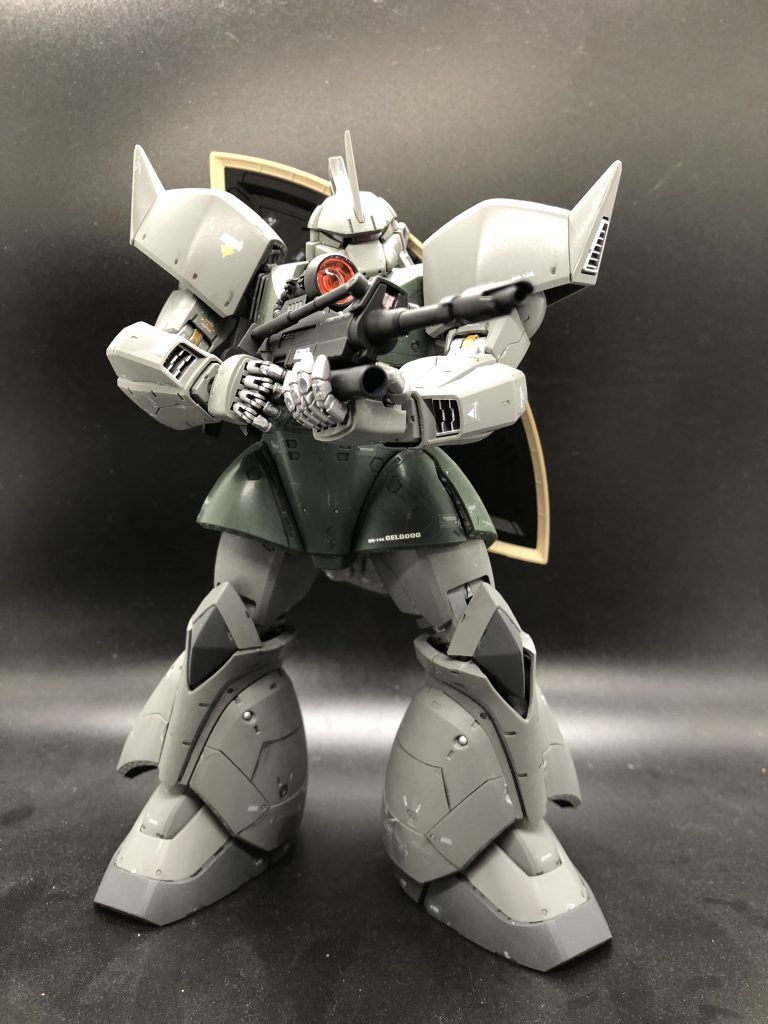
Long considered the flagship brand of Gunpla, Master Grades are marked by having a full inner frame – a detailed robot skeleton that goes under the armor and can stand up on its own – and better coloration, structural integrity, and detail than a High Grade. It’s a wide-ranging set of models, with more than 200 available, just not quite as robust as HG.
Master Grade has a couple of sub-brands. The most common is Ver.Ka, or “Version Katoki”, named for mecha designer Katoki Hajime (who also worked on Virtual On, which rules). His variations on the Gundam designs tend to have leggier proportions, extra details, and several hundred waterslide decals. The announcement of a new Ver.Ka is an event, happening roughly annually, which is just about enough time between releases to finish applying all the goddamn waterslides on the last one. These are some of the best Gunpla you can buy for the money.
A new line of Master Grade Extreme is just starting, with exactly one kit available and another announced. MGEXs are similar to Ver.Kas, but further up the detail and accessories – in the case of the sole extant kit, the RX-0 Unicorn, it comes with fully six huge chainguns, a stand for flight poses, and a set of LED lights built into the skeleton – but you pay for it. There’s no way to sugar coat this: the lone available MGEX is $200.
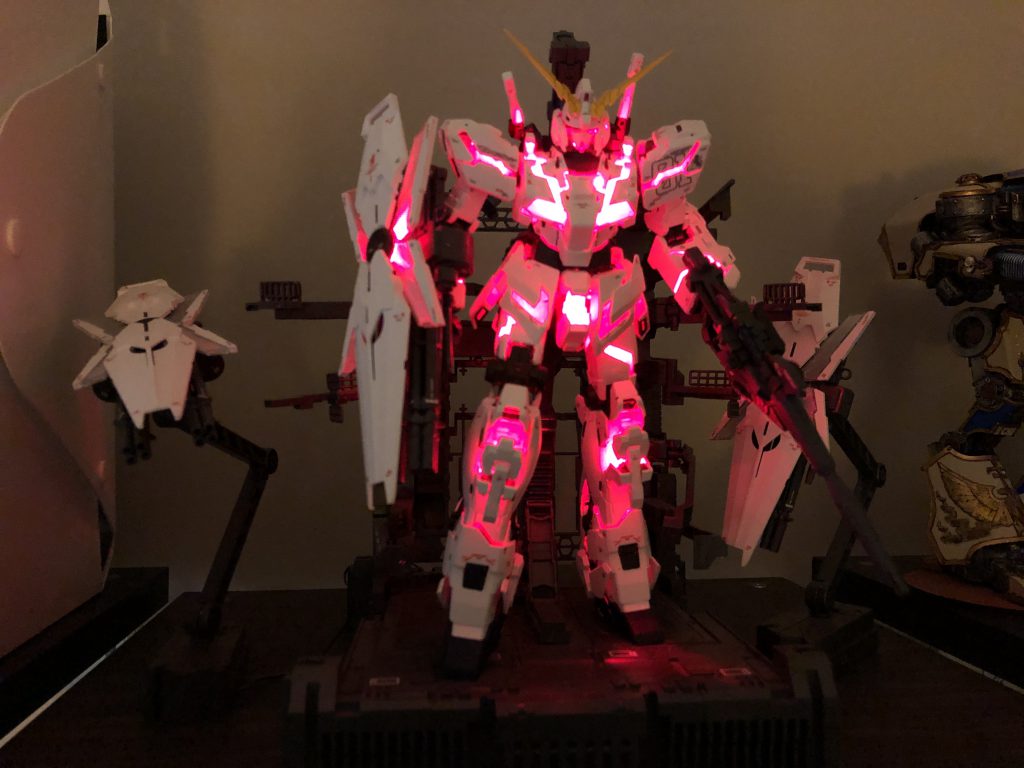
Normal MGs will be $30-60 and 8-10 inches tall. For the most part, these range from wonderful to merely OK. The 0083 and G Gundam MGs are very old and I can’t recommend them, but it’s been basically non-stop gravy since 2010 or so. If you want to customize or detail a kit, even the bad ones are still a solid base to work from.
RG: Real Grade (1/144)
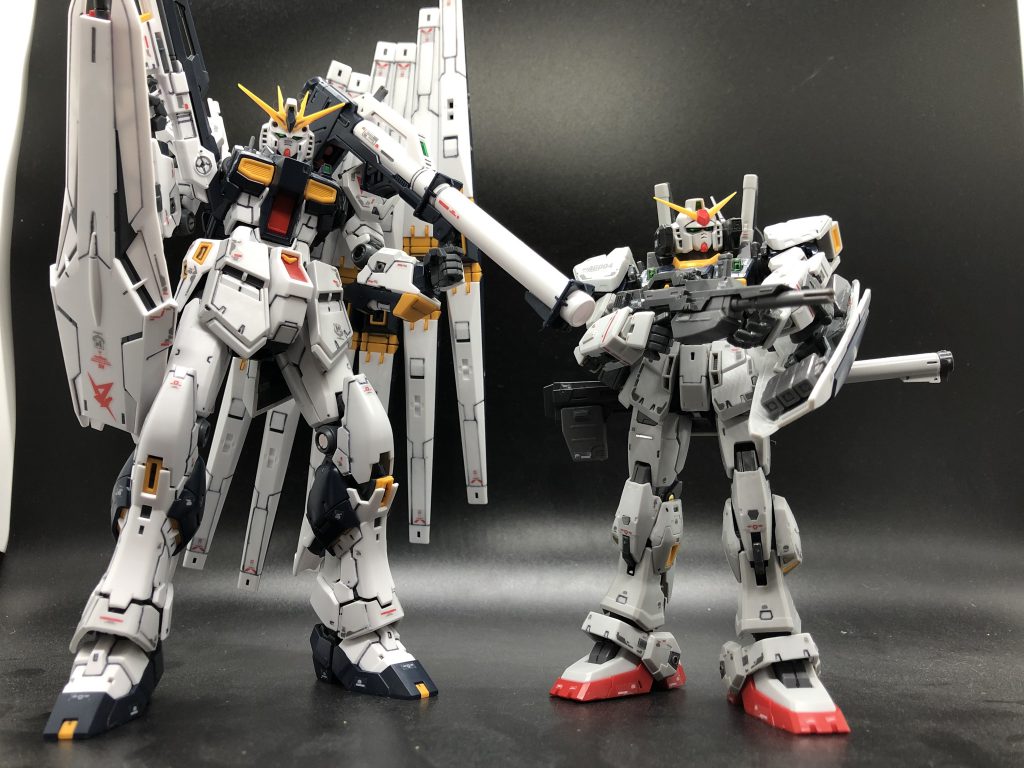
Real Grades are the same size as High Grades, but a massive step up in detail as well as effort. They have a full inner frame, good color accuracy, and will come with the good kind of stickers to add extra detail – the little warning labels that help sell the scale of the thing. Think of a small Master Grade. This is becoming more accurate as Bandai moves away from the pre-molded Advanced Joint System and more toward having to build the damn thing yourself (this is actually an improvement, but still: owned).
There aren’t nearly as many of these as there are HGs, which are the main 1/144 line, but the ones that exist are almost all extremely cool and worth a build. The few exceptions are from where Bandai flew a little close to the sun, and whacked too many gimmicks or tiny parts onto a model, so they look cool but can fall over/apart. RGs typically sell for $30-50.
PG: Perfect Grade (1/60)

Christ. These are the largest lads. The kits usually have 500+ parts that need to be clipped and assembled, but the detail and gimmicks (opening hatches, LED lighting) are the best around. The range is incredibly limited, featuring only one model (the Zaku II) that isn’t a main character’s “hero” Gundam, and even then, there’s only like 12 if you don’t count limited-edition exclusives with color swaps or chrome coatings. The skeletons are very detailed, often at least partially made of die-cast metal, and frankly criminal to cover up with all that armor. Recently, Bandai released a Perfect Grade Unleashed kit of the RX-78-2, which is easily the most impressive thing they’ve done, but there’s no word on whether or when we’ll see more of those.
Perfect Grades run in the $100-200 range, and even the easiest one, with a seasoned builder, is a solid couple of days work. I built one and I hated the experience, though I should note that the one I have – the Wing Zero Custom from Gundam Wing: Endless Waltz – is generally regarded as the worst example.
Other Grades
Bandai has kicked out a few grades that either didn’t pan out or were never meant to.
Entry Grade is a new one, where you can get a full-on Gundam for like 5 bucks and it doesn’t even suck. No stickers, easy to build, very posable, absolute injection molding flex from Bandai. They’re great.
Reborn 100 was intended for odd-ball kits that either wouldn’t sell well or would be cost-prohibitive to produce as full Master Grades. They’re basically a big High Grade. They’ve done other weird things like the Full Mechanics line, which is also a replacement for kits that are never gonna get proper Master Grades and differs from RE/100 in ways I’m unclear on. I actually thought these were both cancelled, but then a Full Mechanics Calamity Gundam just came out, so who knows. RE/100 and FM are inconsistent in quality, but there are some gems.
If you want an even bigger high grade, there’s the MEGA SIZE line, which only has a few models, in a colossal 1/48 scale. Just buy a regular high grade and move it closer to your face, same thing.
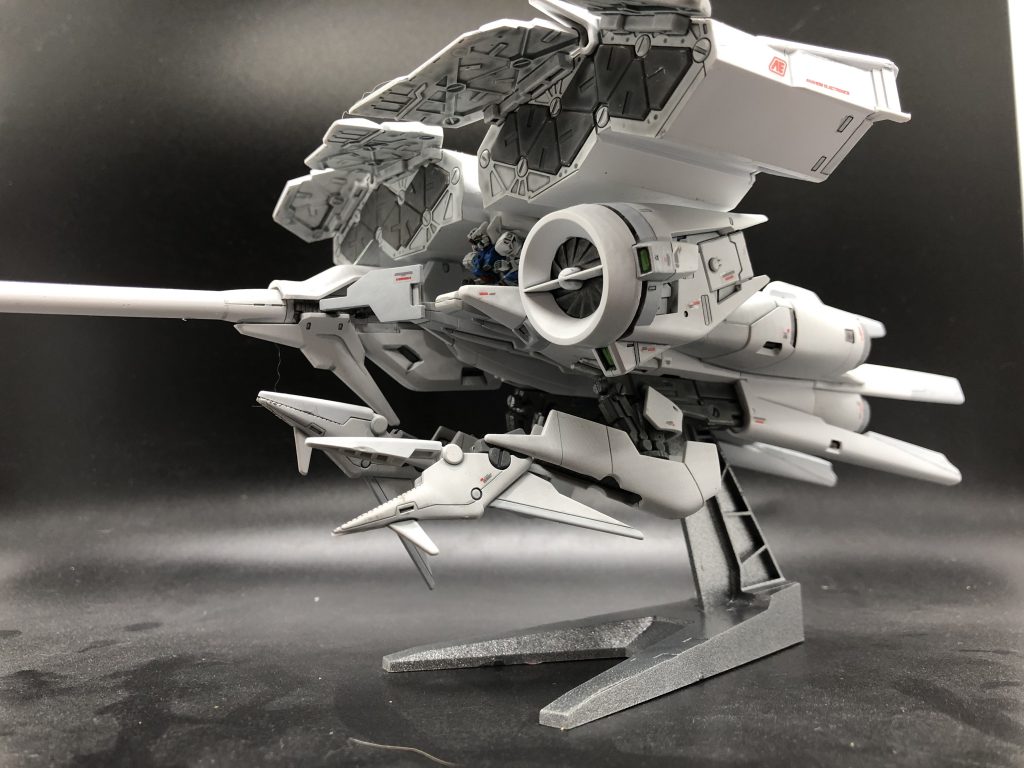
The 1/550 High Grade Mechanics line had three kits, all of them giant mobile armors from 0083. To give a sense of scale, that little dude plugged into the middle of the Dendrobium in the picture above, nestled between the jet engine looking thing and the comically large gun? That’s a whole-ass Gundam.
These are much closer to regular scale model kits than anything else in the Gundam empire, and require paint and glue, which is fairly unique among gunpla. Unfortunately, they can be hard to find these days, which sucks because they’re very cool. This is a defunct grade.
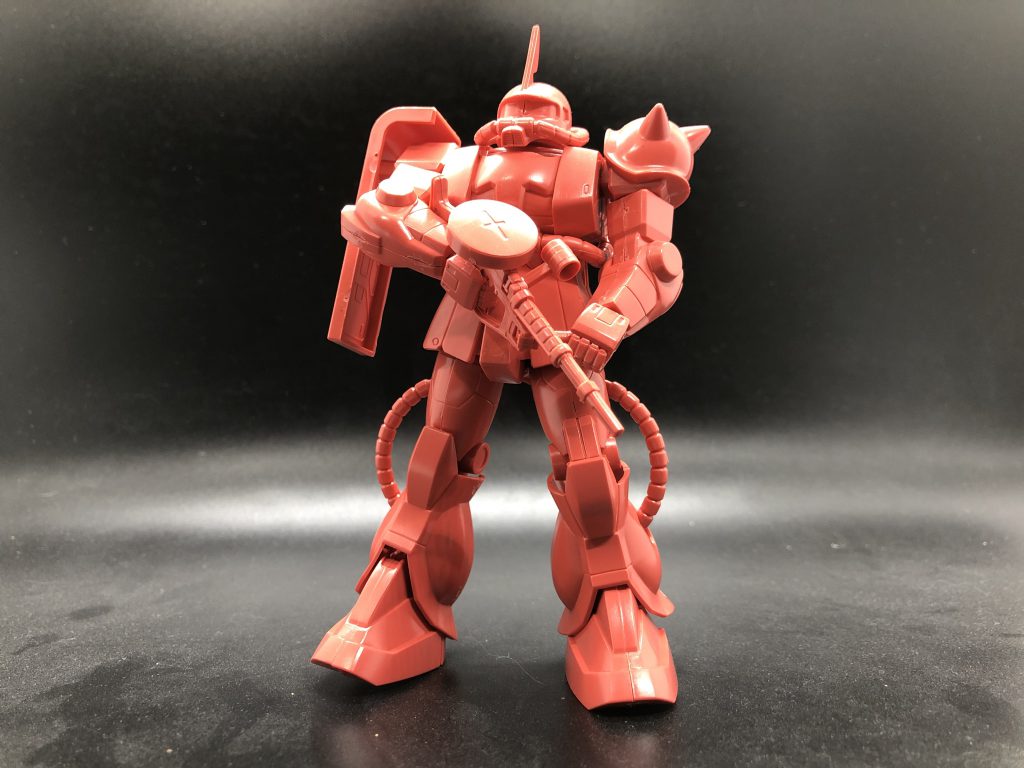
Finally, there’s First Grade, which isn’t even a real product line as much as a name to refer to the old 80s kits that powerfully suck ass, but are a decent winger for being both cheap (I paid $3 for that monochrome Zaku that can barely move) and nostalgic.
Those are the main ones, but there are a whole lot more of these vestigial grades, generally kits from the 1990s, ranging in scale from 1/144 to 1/60, featuring mobile suits from all the different series, that fall under the No Grade moniker. These are best avoided because they variously fall over, fall apart, and/or look like shit. It’s not entirely fair to rag on them, they’re just older designs before the modeling tech was as good as it is now, but I’m gonna do it regardless. I can’t recommend them.
Premium Bandai
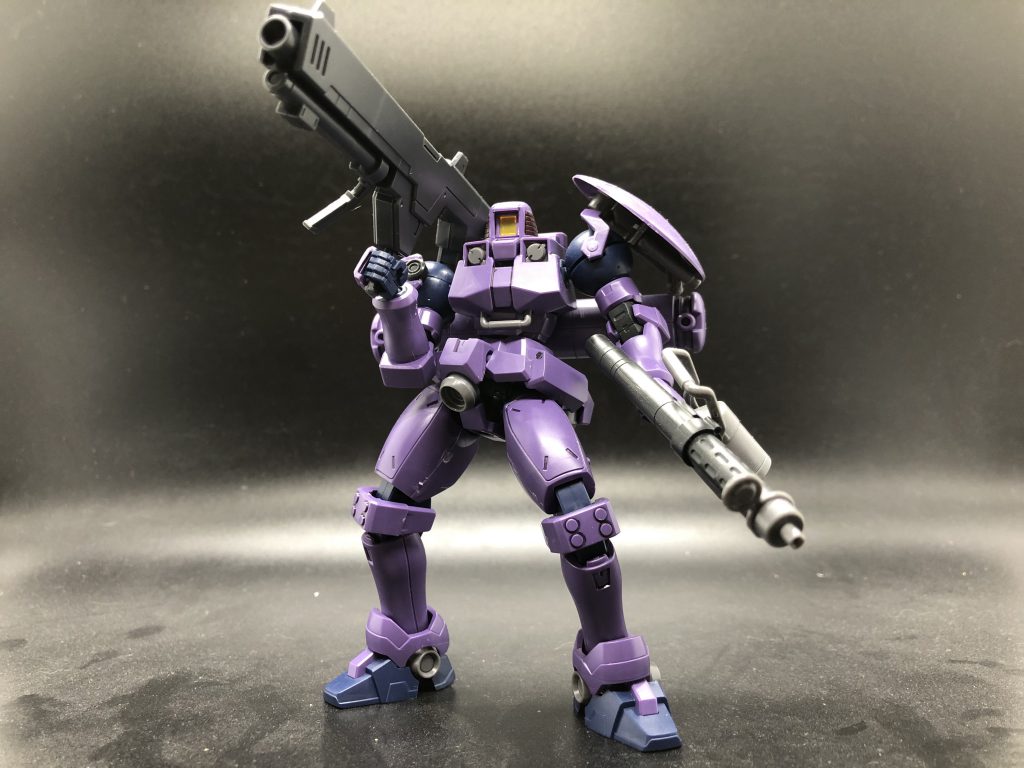
Something akin to Forge World, Premium Bandai, or P-Bandai, kits are a luxury form of gunpla aimed squarely at your wallet. Formerly available only via re-shipping from Japan, P-Bandai has an international webstore now. A couple of complete kits are only available there, but for the most part they sell variants of existing kits. If you wanted a RG Sinanju with a candy apple red paint job, or a semi-transparent version of the MG Alex 2.0, and you don’t mind that it often sells out in a day, ships three months later, and costs four times as much as the base kit, well, this is primarily a Warhammer site. I get it.
This might seem like a lot, but here’s the decision-making flowchart: if you want a small robot, get the RG if there is one and the HG if there isn’t, and if you want a big robot, get the MG. The other stuff you might want to avoid until you get a better handle on things – I would not start off with a Perfect Grade, or shell out for P-Bandai right off the bat.
Next time we’re going to divert into what I really want this column for, which is reviewing some kits. Future installments will go into detailing and painting your gunpla, but know this: you don’t gotta do any of that if you don’t feel like it. Gunplan is freedom. It is fun to build gunpla.
